 |
 |
 |
| |
Impact of prior PI usage on Week 48 responses to
tipranavir boosted with ritonavir (TPV/r)
|
| |
| |
Reported by Jules Levin
XVI Intl AIDS Conference, Toronto, Aug 2006
R. B. Pollard1, S. Staszewski2, R. LeBlanc3, D. Neubacher4, H. Valdez4
1University of California, Davis, CA, USA; 2Univ Hosp Frankfurt, Germany; 3McGill University Health Center, Montreal, Québec, Canada;
4Boehringer Ingelheim Pharmaceuticals, Inc., Ridgefield, CT, USA
Abstract
The Phase III RESIST trials demonstrated that TPV/r was significantly more effective than an optimized comparator PI/r (CPI/r). This analysis assessed the impact of previous PI use on various outcomes at Week 48.
Methods RESIST patients had >/=3-class ARV experience, including >/=2 PI-based regimens; any CD4 cell count; viral load (VL) 31000 copies/mL; and HIV isolates carrying >/=1 primary PI mutation and >/=2 mutations at 33, 82, 84, 90. Patients were randomized to receive TPV/r (500 mg/200 mg BID)
or pre-selected CPI/r plus optimized background regimen. Treatment response (TR) was defined as a confirmed >/=1 log10 copies/mL decrease in VL from baseline without treatment change.
Results 1483 patients were randomized: 746 TPV/r; 737 CPI/r. Baseline mean CD4 cell counts: 196/195 cells/mm3; mean VLs: 4.73/4.73 log10 copies/mL in TPV/r and CPI/r arms respectively. Greater proportions of patients in the TPV/r arm had a TR or VL <400 or <50 copies/mL than control patients. With increased PI experience, responses to CPI/r were impaired to a greater extent than
those to TPV/r.
- Patients who had taken two or three previous PIs had better treatment response rates and were more likely to achieve undetectable VLs if they took TPV/r than if they took a CPI/r.
- TPV/r was effective in patients with a broad range of PI experience. However, better results were observed in patients with limited prior PI use. The most likely explanation for this observation is that these patients had a greater number of genotypically active ARVs to form a suppressive background regimen.
- Combining TPV/r with a suppressive background regimen is the best strategy in order to achieve a durable virological and immunological response in patients with prior PI experience.
Week 48 Virologic Responses
Prior 2 PIs: 35% <50 c/ml; 42% Treatment Responders
Prior 3 PIs: 28% <50 c/ml; 38% Treatment Responders
Prior 4 PIs; 22% <50 c/ml; 33% Treatment responders
Prior 5 PIs: 15.7% <50 c/ml; 30% Treatment Responders
Prior 6 PIs: 17.6% <50 c/ml; 28% Treatment responders
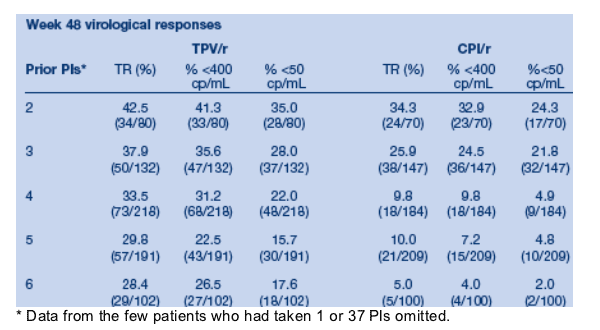
Conclusions At all levels of PI experience, TPV/r provided superior treatment efficacy over CPI/r at Week 48. This difference increased with increasing PI experience. Patients who started TPV/r with limited (<3) PI experience, and able to take active background ARVs, had better treatment outcomes at Week 48 than those with greater PI experience.
Introduction
Tipranavir (TPV, Aptivus®) is a novel protease inhibitor (PI) with potent activity against multiple PI-resistant HIV-1. TPV/r is effective and well tolerated in patients who have taken 32 PI-based regimens [1-3].
The efficacy and safety of TPV/r (500/200 mg BID) is being evaluated in the RESIST 1 and 2 studies, which are randomized, ongoing, open label, comparative Phase III trials [2, 3]. RESIST 1 is taking place in N America and Australia; RESIST 2 is being conducted in Europe and Latin America.
The RESIST studies enrolled triple antiretroviral (ARV) class experienced patients, who were followed for at least 96 weeks. Patients were randomized to receive an optimized background regimen (OBR) plus TPV/r or a standard of care, ritonavir boosted, comparator PI (CPI/r). Since the study designs of RESIST 1 and 2 were similar, the data from both trials were combined for analysis.
Patients who fail successive PI regimens are at increasing risk of being unable to achieve an undetectable VL because of the emergence of cross resistant virus and the decreased availability of background ARVs to form a suppressive regimen [4]. It is important to identify the best PI/r option for this group of patients.
We present the results of an analysis comparing the Week 48 efficacy of TPV/r and CPI/r regimens in patients stratified by their previous PI experience.
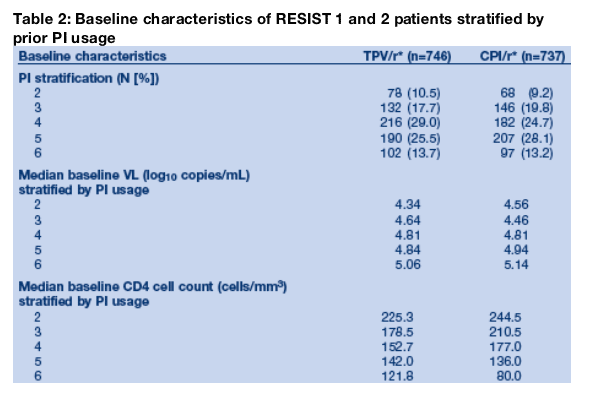
Treatment response rates
The overall treatment response rates at Week 48 were 33.6% (251/746) in the TPV/r arm and 15.3% (113/737) in the CPI/r arm (p<0.001) (Intention to Treat, Non completer = Failure [ITT NC=F]).
Treatment responses were consistently higher in the TPV/r arm than the CPI/r arm, regardless of the PI experience of the patients (2-6 prior PIs) (Figure 2). As the degree of PI experience increased, the differential between the two arms increased: 28.4% (29/102) of RESIST patients who had previously received six PIs and then took TPV/r had a treatment response as compared to 5% (5/100) of those taking a CPI/r. This was more than a five fold difference between the two groups.
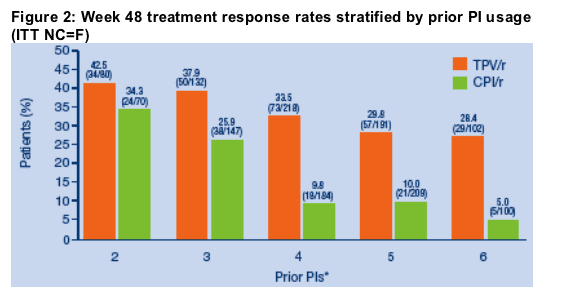
Proportion of patients with VL <400 copies/mL
Overall, 30.4% (227/746) of patients who took TPV/r achieved a VL <400 copies/mL at Week 48 compared to 13.8% (102/737) of control patients (p<0.0001) (Figure 3). In all strata of PI experience, patients who took TPV/r were more likely to have a VL <400 copies/mL at Week 48 than those who
took a CPI/r (Figure 3).
The difference between the two groups, in terms of viral suppression to <400 copies/mL, was evident even in patients who had only taken two previous PIs: 41.3% (33/80) in the TPV/r arm vs. 32.9% (23/70) in the control arm. At increasing levels of PI experience, the differential between the two arms became even greater: patients who had taken six prior PIs were nearly seven (6.63) fold
more likely to have an undetectable VL (<400 copies/mL) if they took TPV/r compared to a CPI/r.
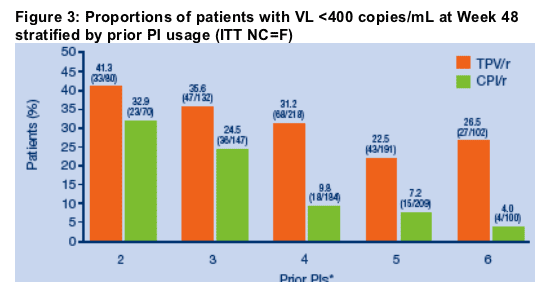
Proportion of patients with VL <50 copies/mL
In the total RESIST population, 22.8% (170/746) of patients who took TPV/r achieved a VL <50 copies/mL at Week 48 compared to 10.2% (75/737) of control patients (p<0.0001). At all levels of PI experience, patients who took TPV/r were more likely to have a VL <50 copies/mL at Week 48 than those who took a CPI/r (Figure 4). Even in patients who had only taken two previous PIs, the difference was considerable: 35.0% (28/80) in the TPV/r arm vs. 24.3% (17/70) in the control arm had VLs <50 copies/mL. In patients with more extensive PI experience, the differential between the two arms was even larger: patients who had taken six prior PIs were nearly nine (8.8) fold more likely to have an undetectable VL if they took TPV/r compared to a CPI/r.
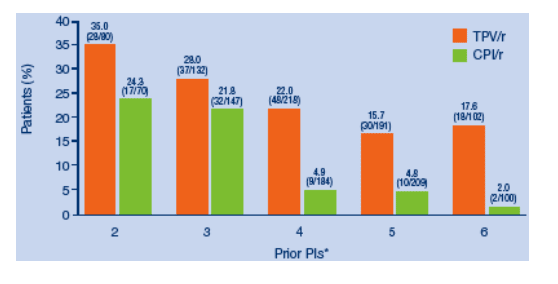
|
| |
|
 |
 |
|
|